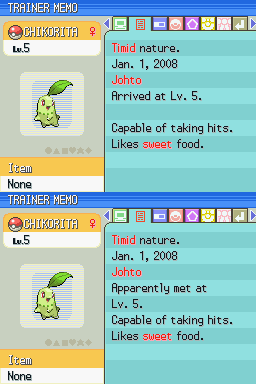Remake
A video game remake is a game that is done again, in a new and updated style. In Pokémon terms, two pairs of games are remakes: Pokémon FireRed and LeafGreen, remakes of the Generation I games Pokémon Red and Green during Generation III; and Pokémon HeartGold and SoulSilver, remakes of the Generation II games Pokémon Gold and Silver during Generation IV. The names of remakes are derived by adding another word to the front of the name of the original game, and written in CamelCase.
Remake speculation

|
This article contains fan speculation. There is no solid evidence for or against some parts of this article. |
Before the announcement of Pokémon HeartGold and SoulSilver, many had speculated a remake of Gold and Silver since the release of Pokémon FireRed and LeafGreen in 2004. In the Generation IV games, location pointer data (for a caught Pokémon's status screen) includes a reference to Johto, much like it does for Kanto and Hoenn when a Pokémon is transferred forward from Generation III. This left programmers the opportunity to see Johto make an appearance in future games compatible with Diamond, Pearl, and Platinum. However, Pokémon caught in Pokémon HeartGold and SoulSilver and traded to Diamond, Pearl, and Platinum have location data set to Faraway place.
Because of the "pattern" established by remaking both Red and Green and Gold and Silver two generations after their original release, it is now being speculated that Generation III remakes may appear sometime in the future, possibly during Generation V. This theory is strengthened by the number of references to the Generation III games:
- Many Pokémon obtainable only through methods the Dream World or Poké Transfer in Pokémon Black and White can be obtained in the Hoenn games.
- A Backpacker in Desert Resort tells the player that he comes from Hoenn, and that he doesn't need the Go-Goggles here unlike in Hoenn.
- The inclusion of a skilled family of Pokémon Trainers that can be battled.
- In Undella Town during Summer, a boy tells the player that he and his family comes from Hoenn and visit Undella Town every Summer. A girl also mentions Steven Stone.
- Ocean currents reappear in Route 17 and 18
- Separate music for the Elite Four and the Gym Leaders, as in Generation III.
- Generation V's Elite Four theme features a remixed sample from the Generation III Elite Four theme.
- An area with sandstorm that can be accessed before the Elite Four.
- The introduction of another cactus-based Pokémon.
- The sixth Gym Leader of Unova, Skyla, is a Flying-type specialist and lives near a rainy area, like Winona from Hoenn and both are the sixth Gym Leader in their respective regions.
- No characters introduced in Generation III are reused in Black and White, unlike other generations which saw characters repeated in these games. Cynthia, Looker, Caitlin, and a former Team Rocket Grunt were introduced before they appeared in Black and White.
- Both Hoenn and Unova have ancient locations that show written messages of a unique language, Braille and Cuneiform respectively.
- Generation III introduced double battles, while Generation V introduced triple battles.
- Steven appears in HeartGold and SoulSilver and gives the player one of the Hoenn starters after obtaining all 16 badges. He later trades his Beldum for the player's Forretress.
- The introduction of the Jade Orb, Rayquaza's equivalent of the Red and Blue Orbs.
- The inclusion of the Dive HM, which was previously exclusive to Generation III.
- The inclusion of two rival characters, similar to Generation III.
- A fossil depicting an Armaldo in the Nacrene City museum.
- Basculin has both a Red-Striped and Blue-Striped form.
- Zekrom glows blue while Reshiram glows red.
- Both involved an upheaval to the Pokédex structure: Pokémon Ruby and Sapphire was the first game to have a regional Pokédex excluding all, save for a few, Pokémon from previous generations as well as being incompatible with previous games, while Pokémon Black and White's regional Pokédex was the first to contain no Pokémon from previous Generations.
- They also involve introducing little to no evolutionary relatives from their previous generations.
- Both also do not introduce another Eeveelution.
- Ash's party mainly consisting of Pokémon he used during the Advance Generation series in The Semi-Final Frontier!.
- The appearance of the Lava Cookie in The Brockster is In!, among other items featured like the Pecha Berry, which also made its first appearance in the Generation III games, and the Heal Powder.
- Dawn deciding to travel to Hoenn to compete in Contests in SS024, as May before her did in Johto.
- The inclusion of Pokémon-ex in an upcoming TCG expansion, a type of card previously exclusive to the EX Series.
Trivia
- Both sets of remakes are to date the only main series Pokémon games to come bundled with an accessory. FireRed and LeafGreen originally had the Game Boy Advance Wireless Adapter bundled with them, while HeartGold and SoulSilver are bundled with the Pokéwalker.
- Each of these accessories is a precursor to a feature found in the following generation. Generation IV expanded on the Wireless Adapter's features with the Nintendo DS's wireless play, while Generation V's Dream World is a more robust version of the Pokéwalker.
- Both sets of remakes also use artwork on the boxart other than the official artwork released with the game.
- A new female player character has been introduced in each set of remakes.
- Remade games are retconned to the point of including all known Pokémon as of their release generation, not just the Pokémon available in the original release.

|
This game-related article is part of Project Games, a Bulbapedia project that aims to write comprehensive articles on the Pokémon games. |
